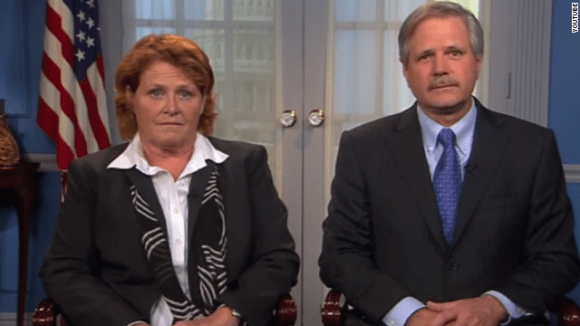WASHINGTON, DC. (NewsDakota.com) – North Dakota U.S. Senator’s Heidi Heitkamp and John Hoeven successfully included in the new congressional funding bill a provision that will keep in place an existing flood wall in Valley City.
Without the fix, the federal government would have forced the city to remove the flood wall – which would have reduced flood protection and cost the city nearly $150,000 to remove it.
The announcement follows a meeting Heitkamp held March 10 with Valley City officials involved in flood protection efforts during which she updated them about her efforts to try to include her provision in the funding bill.
According to Senator Heitkamp’s news release, “This is incredibly exciting news as Valley City will now be able to keep the flood wall the city constructed to provide permanent, comprehensive flood protection so area families and businesses are safe from potential floods,” said Heitkamp. “In 2009 and 2011, Valley City witnessed firsthand the serious damage of intense flooding, and the city should be rewarded for its efforts to prevent such harm from future floods. Without this fix that I’m proud to have successfully written and included in the congressional funding bill, FEMA would have forced Valley City to remove the flood wall. Instead, now, Valley City will be able to keep strong flood protection in place – that’s encouraging for the safety of area families and businesses as they will know for certain that the flood wall the city built will remain well into the future.”
After Valley City built a flood wall to provide permanent flood protection to keep residents safe, it became known that the land where part of the wall is located is deed restricted because the land was purchased through the U.S. Federal Emergency Management Agency’s (FEMA) Hazard Mitigation Grant Program. As a result, FEMA had told the city to remove the flood wall at a cost of at least $150,000 — despite the fact that the entire purpose of the Hazard Mitigation Grant Program is to reduce impacts from natural disasters, including flooding — and then develop an alternative flood protection plan, which would cost hundreds of thousands of dollars more.
That bill must pass in Congress by March 23. Heitkamp had been working with senators on the Senate Appropriations Committee and Senate Homeland Security Committee to press the issue, as well as with the North Dakota State Water Commission and the North Dakota Department of Emergency Services to gather their input.

In a news release issued by Senator John Hoeven’s office, he announced that he also secured a provision in the Fiscal Year 2018 funding legislation to allow Valley City to keep an existing flood wall near Valley City State University that was inadvertently built on land acquired using the Federal Emergency Management Agency’s (FEMA) Hazard Mitigation Grant Program (HMGP). Under FEMA policy, no permanent structure can be built on land that has been bought out by FEMA.
He added, “As a member of the Appropriations Committee, I worked to secure this provision which enables Valley City to keep its flood wall, which is vital to the community’s flood control efforts,” Hoeven said. “Keeping this flood wall in place will help ensure long term flood protection for Valley City and provide residents security and peace of mind.”
Specifically, Hoeven’s provision authorizes FEMA to allow Valley City to retain flood protection systems inadvertently built on HMGP land.
The flood fights in Valley City during the 2009 and 2011 floods – the first and second worst floods in the city’s history – cost $19 million, of which $16 million was state and federal funds and $3 million was local funds. Following those floods, the city has been working to put in place permanent flood protection to keep the city and residents protected and reduce costs.
This first phase of the project where a combination of a flood wall and levee were constructed to protect the university area, which includes 79 homes and seven businesses with a combined value of $49 million, is where the FEMA deed restricted lot in question is located. This part of the city’s comprehensive flood protection effort was completed in 2016 and the city took great care to avoid three other FEMA deed restricted lots in developing and constructing the project, however, the lot in question was identified as city-owned. Last year, it was discovered the lot had been purchased with FEMA Hazard Mitigation Grant Program funds.
